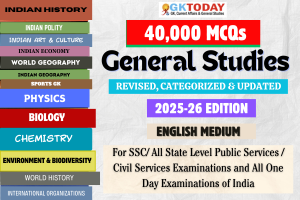Multiple Choice Quiz Questions (MCQs) on Ancient Indian History for General Studies and GK preparation of SSC, NDA, CDS, UPSC, UPPSC and State PSC Examinations.
41. Which of the following is the only Vakataka ruler to whom the title ‘samrat’ was accorded?
[A] Vindhyasakti
[B] Pravarasena
[C] Rudrasena II
[D] None of the above
Show Answer
Correct Answer: B [Pravarasena]
Notes:
Pravarasena who was the father of Vindhyasakti is the only Vakataka ruler to whom the title ‘samrat’ was accorded. He performed ‘Vajapeya’ and four ‘Ashvamedha’ sacrifices.
42. Which of the following was the greatest Hindu philosophers and teachers of the post-Gupta period who popularised the devotion to Siva?
[A] Shukracharya
[B] Sankaracharaya
[C] Pasupatacharya
[D] None of the above
Show Answer
Correct Answer: B [Sankaracharaya]
Notes:
Sankaracharya was born in the Chera country around the year 788 A.D. He popularised the devotion to Siva among the people of India. He is considered as one of the greatest Hindu philosophers and teachers of the post-Gupta period.
43. Which of the following rhetoricians belong to the Medieval period?
1) Udbhat,
2) Vamana,
3) Anandavardhana
4) Ahinavagupta
Select the correct option from the codes given below:
[A] Only 1 & 2
[B] Only 2 & 3
[C] Only 1, 3 & 4
[D] 1, 2, 3, & 4
Show Answer
Correct Answer: D [1, 2, 3, & 4]
Notes:
The Medieval period is called the golden age of Sanskrit poetics. Many great poets and rhetoricians belong to the medieval period like Udbhat, Vamana, Rudrata, Anandavardhana, Ahinavagupta, and Kuntaka or Kuntala.
44. During the reign of which of the following kings, the temple of Sangamesvara at Pattadakal in Bijapur District was constructed?
[A] Vijayaditya
[B] Vikramaditya I
[C] Vikramaditya II
[D] Pulakesin II
Show Answer
Correct Answer: A [Vijayaditya]
Notes:
King Vijayaditya who ruled the Deccan Chalukyas from A.D. 696 to 733 built the great temple of Siva under the name of Vljayesvara now called Sangamesvara at Pattadakal in Bijapur District.
45. Which of the following was the founder of the Chola dynasty?
[A] Aditya I
[B] Parantaka I
[C] Vijayalaya
[D] None of the above
Show Answer
Correct Answer: C [Vijayalaya]
Notes:
Vijayalaya founded the Chola dynasty in 9th century CE. He was earlier a feudatory of the Pallavas. He established his might in the area around Eraiyur. He captured Tanjore and extended his kingdom along the lower Kaveri region.
46. Which of the following places emerged as an important weaving industry centre during the Chola administration?
[A] Ujjain
[B] Madhurai
[C] Kanchipuram
[D] Kudamukku
Show Answer
Correct Answer: C [Kanchipuram]
Notes:
The early medieval period marked a significant improvement in the craft techniques and various centers of craft production emerged. during the Chola administration, Kanchipuram emerged as an important weaving industry center.
47. During the Chola administration, the Royal court of justice was also called as?
[A] Eccoru
[B] Kadamai
[C] Antarayam
[D] Dharmasana
Show Answer
Correct Answer: D [Dharmasana]
Notes:
During the Medieval period, justice was mostly a matter of local concern. The village assemblies enjoyed great powers in the field of justice. We have the mentions of Dharmasana recorded in Chola inscriptions. Dharmasana was the Royal court of justice.
48. Which of these is discussed in Pancha Siddhantika by Varaha mihira?
[A] Anatomy
[B] Astrology
[C] Medicine
[D] Astronomy
Show Answer
Correct Answer: D [Astronomy]
Notes:
The most famous work by Varahamihira is the treatise on mathematical astronomy called the Pancha Siddhantika (“Five Astronomical Treatises”). It is dated 575 AD. It is a summary of five earlier astronomical systems, namely the Surya, Romaka, Paulisa, Vasistha and Paitamaha.
49. Who was the last ruler of the Nanda dynasty?
[A] Kaivarta
[B] Dhanananda
[C] Panduka
[D] Govishanaka
Show Answer
Correct Answer: B [Dhanananda]
Notes:
The Nanda dynasty ruled in northern part of the India during the 4th century BCE. Dhana Nanda, according to the Buddhist text Mahabodhivamsa, was the last ruler of the Nanda dynasty of ancient India. He was the youngest of the eight brothers of the dynasty’s founder Ugrasena. Panduka was the second king of this dynasty. Govishanaka was sixth king of Nanda dynasty. Kaivarta was the eighth king of this dynasty.
50. Which ruler was titled as ‘Ekabrahmana’?
[A] Kharavela
[B] Susharman
[C] Pushyamitra Sung
[D] Gautamiputra Shatkarni
Show Answer
Correct Answer: D [Gautamiputra Shatkarni]
Notes:
Gautamiputra Satakarni was a patron of Brahmanism. He was the twenty third ruler of the Satavahana Dynasty and ruled for 24 years between 62 – 86 A.D. In the Nasik inscription of Balasri, Gautamiputra Satakarni is called ‘Ekabrahmana’ which means either ‘unrivalled Brahmin’ or ‘the only protector of the Brahmins’.
 These questions are part of GKToday's 40,000+ GK Questions Course in GKToday Android Application which provides more than 40K questions with explanations suitable for all Competitive Exams of India.
These questions are part of GKToday's 40,000+ GK Questions Course in GKToday Android Application which provides more than 40K questions with explanations suitable for all Competitive Exams of India.
